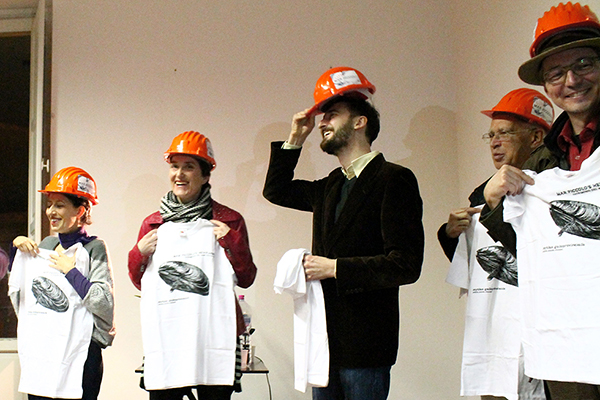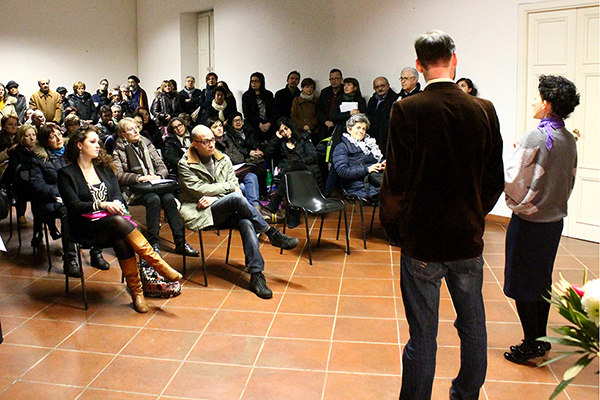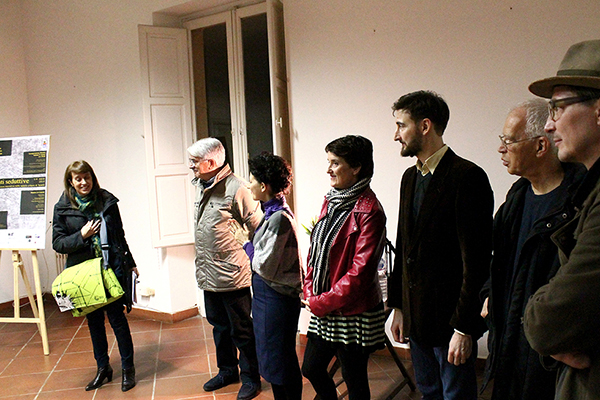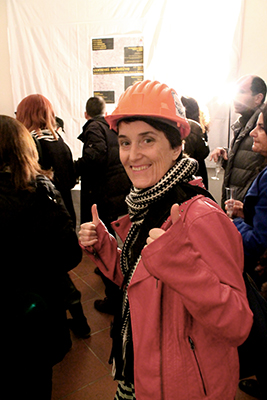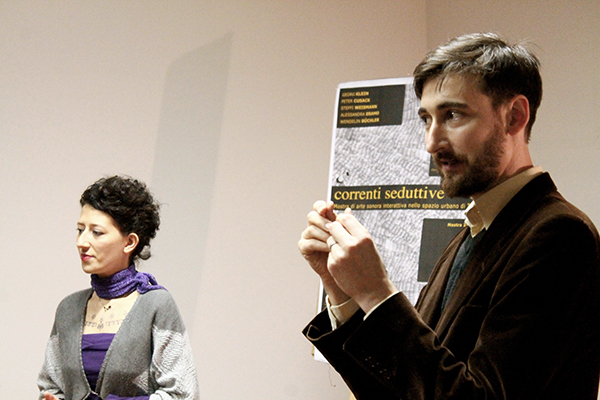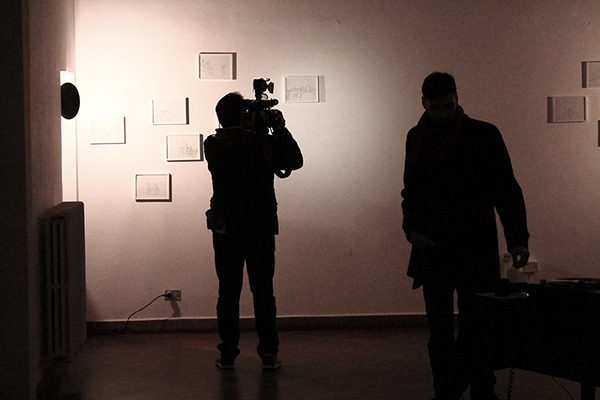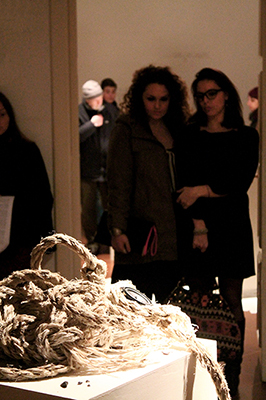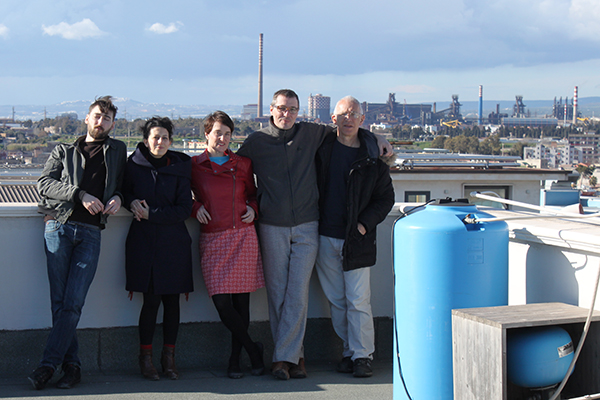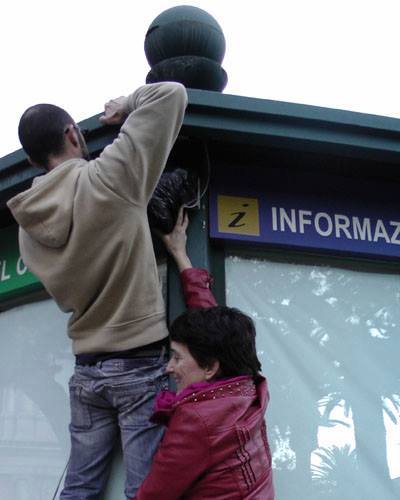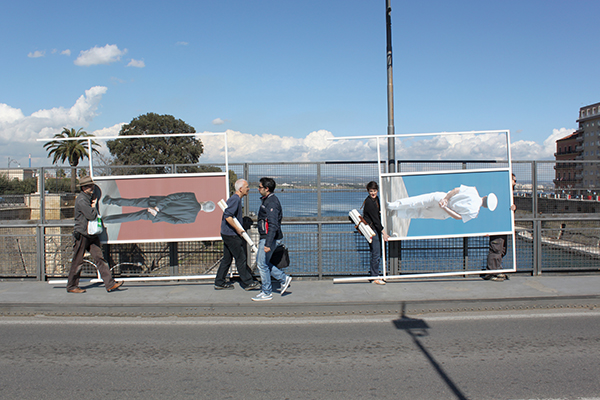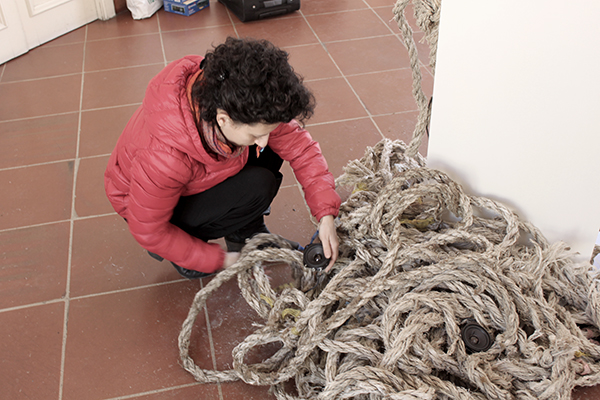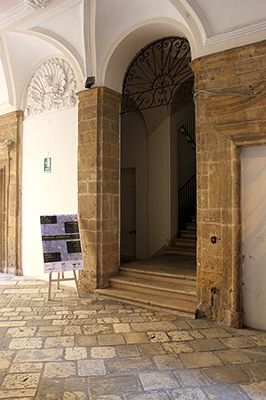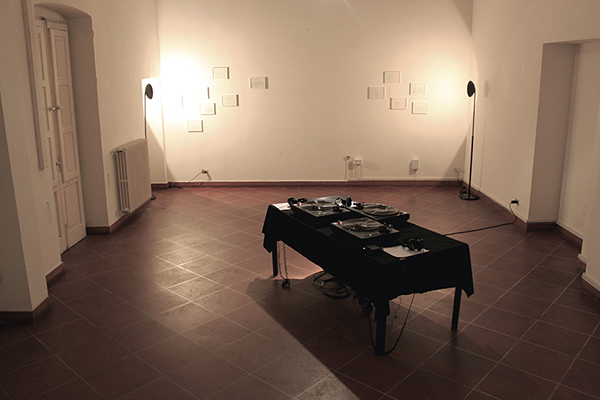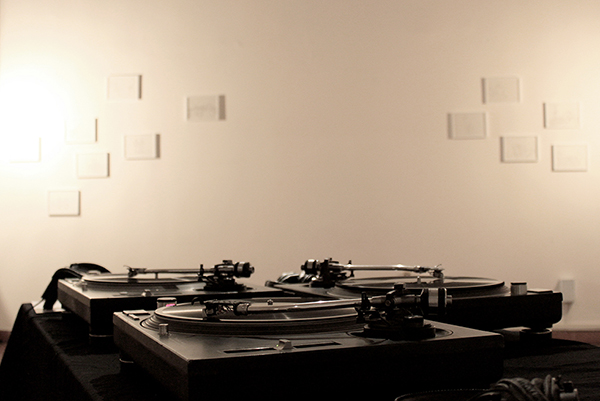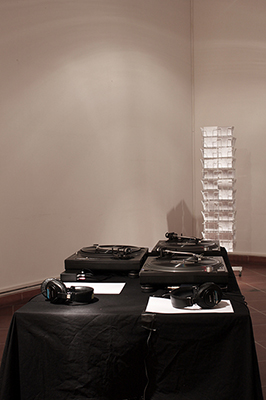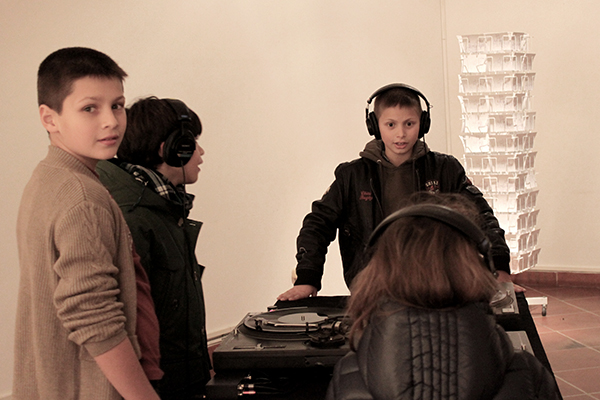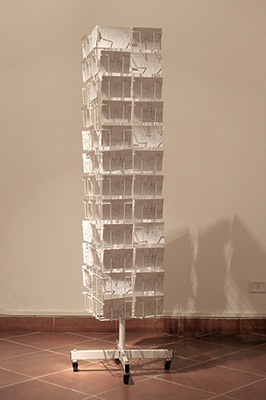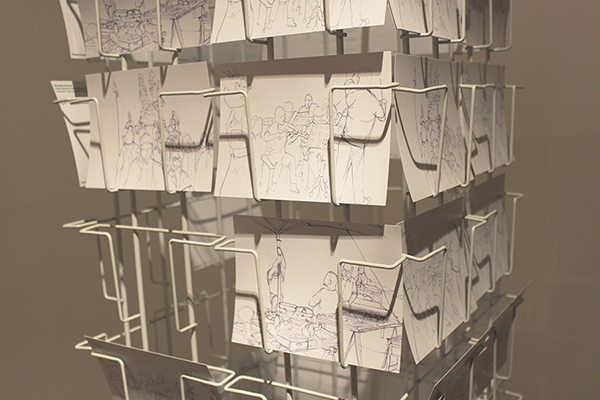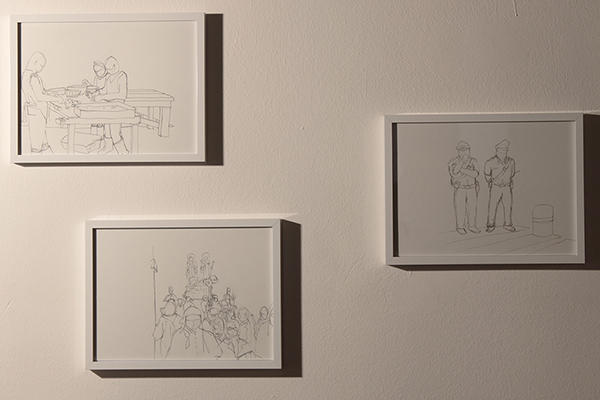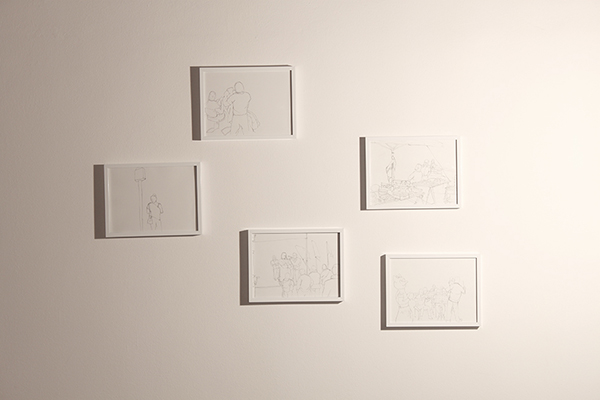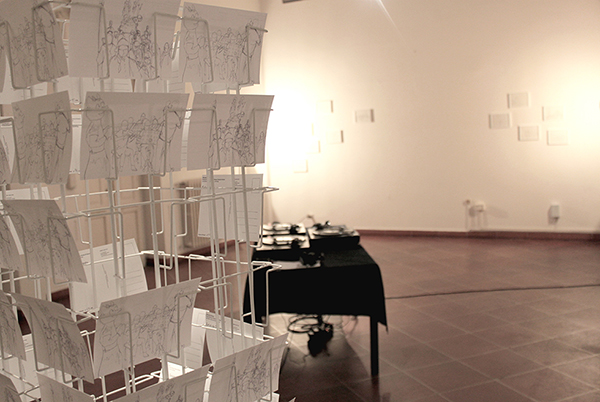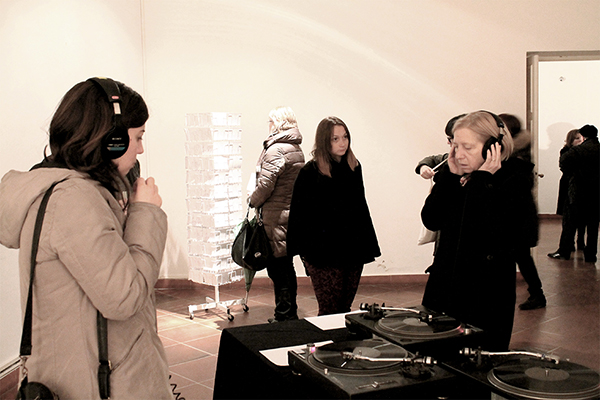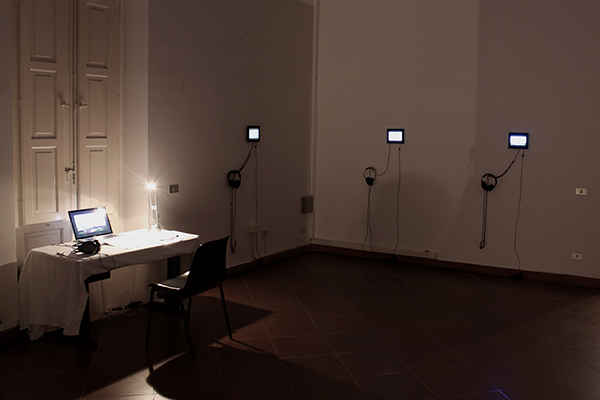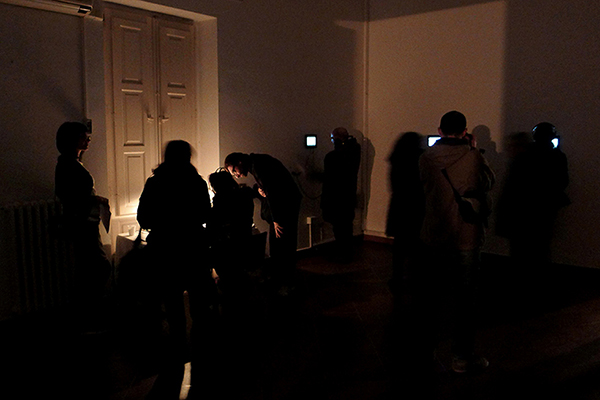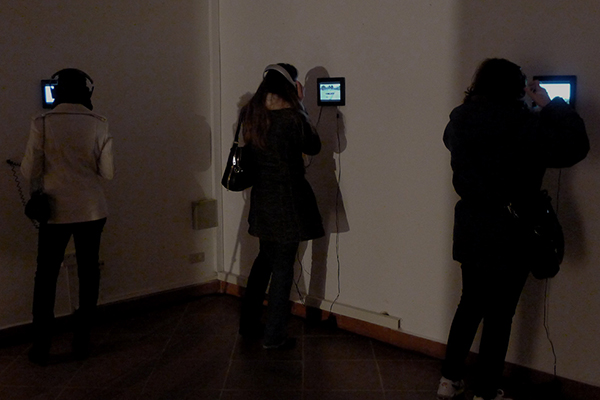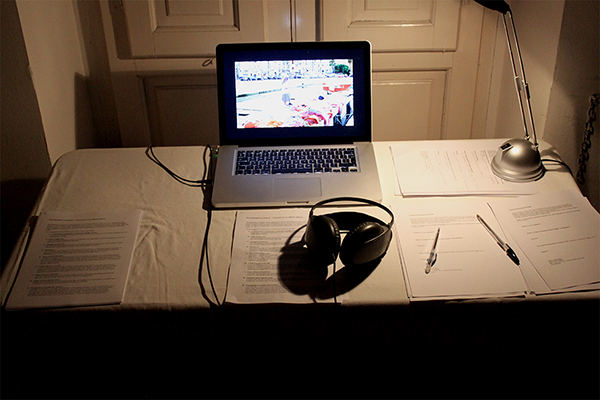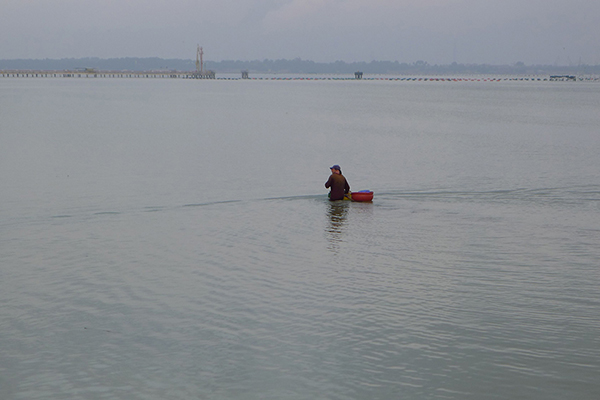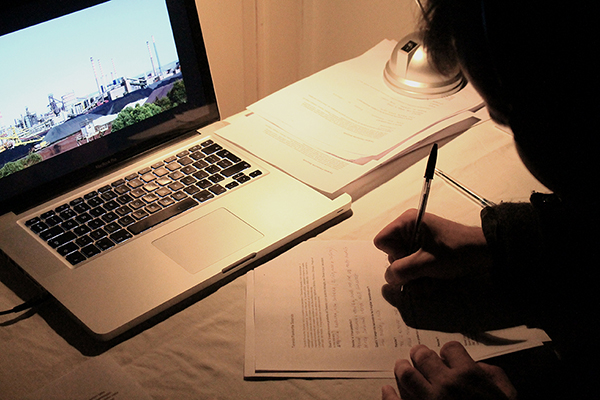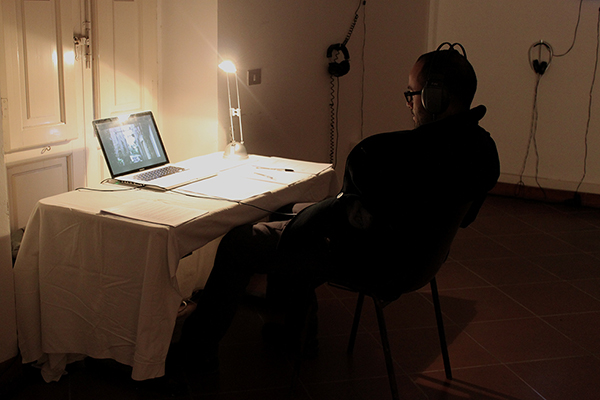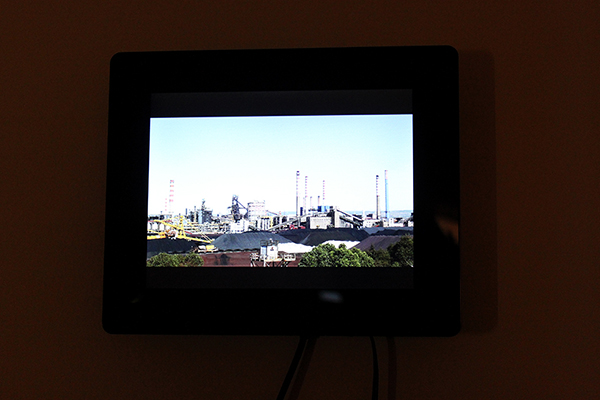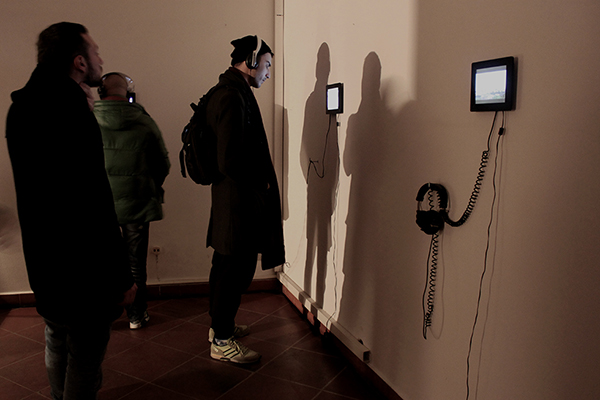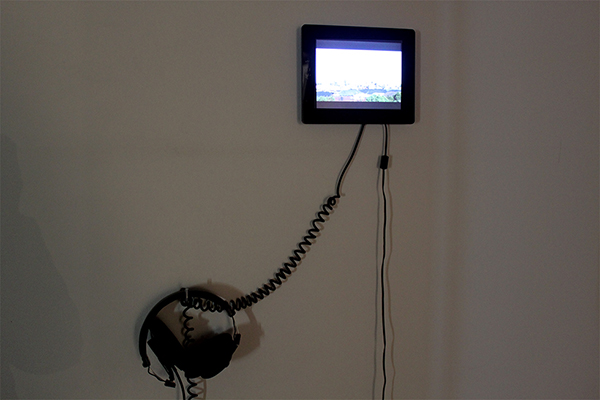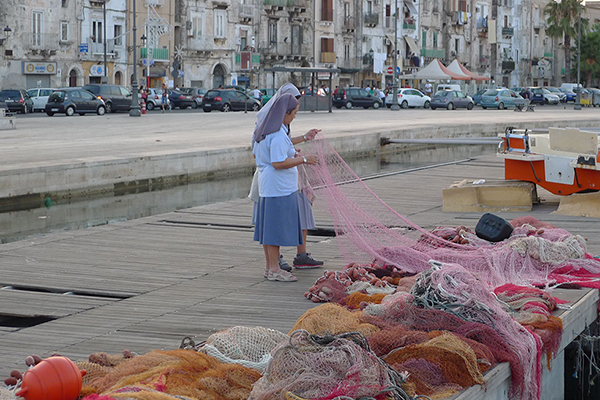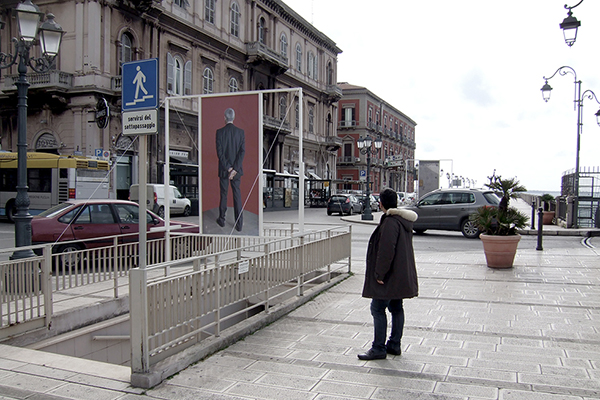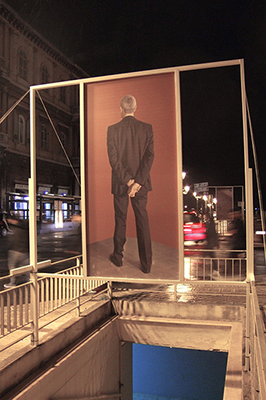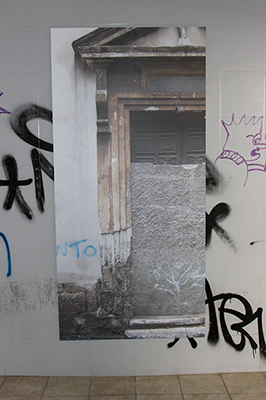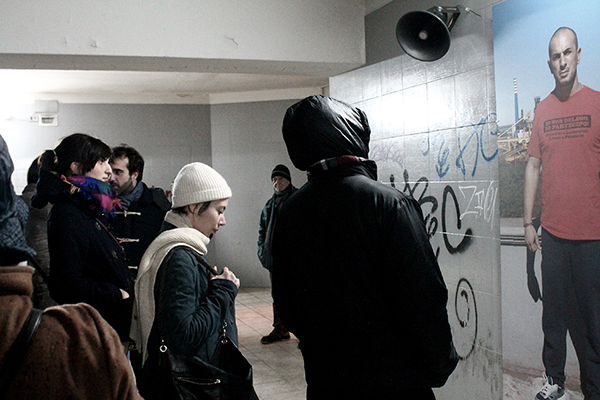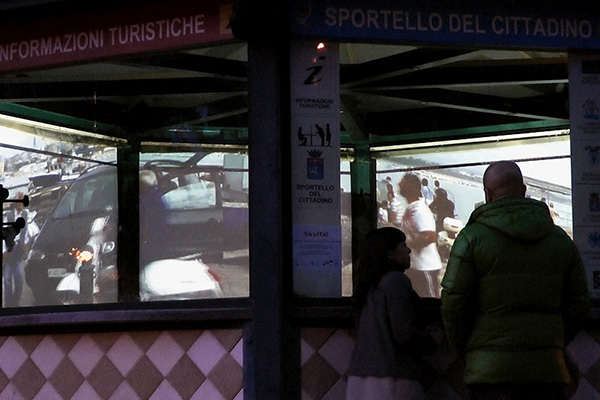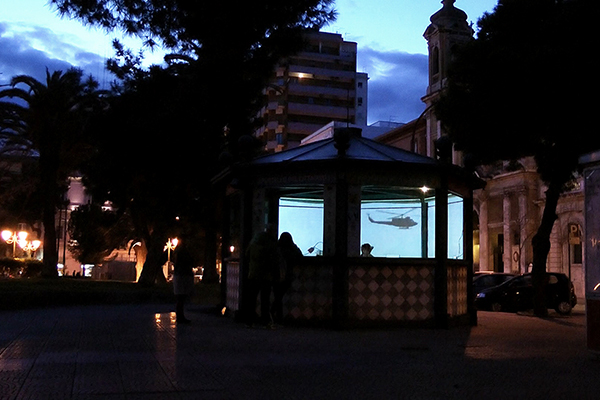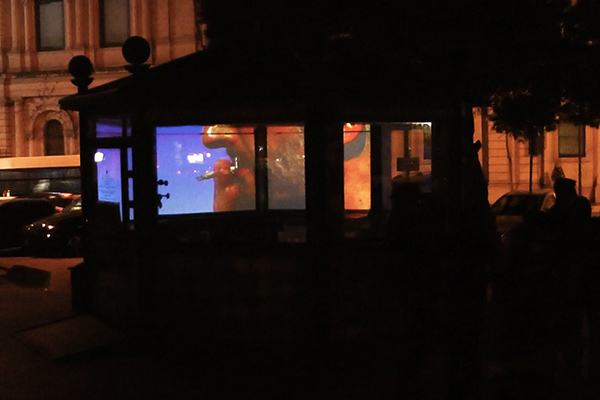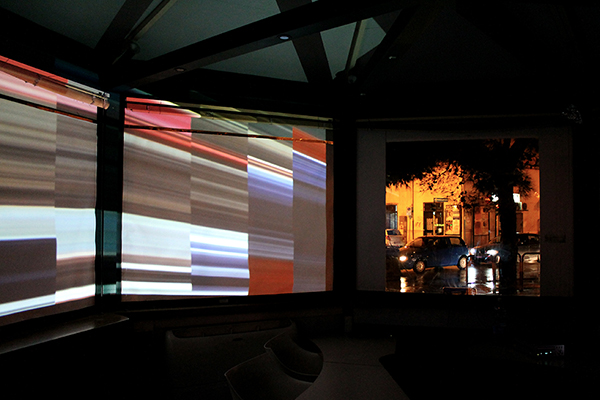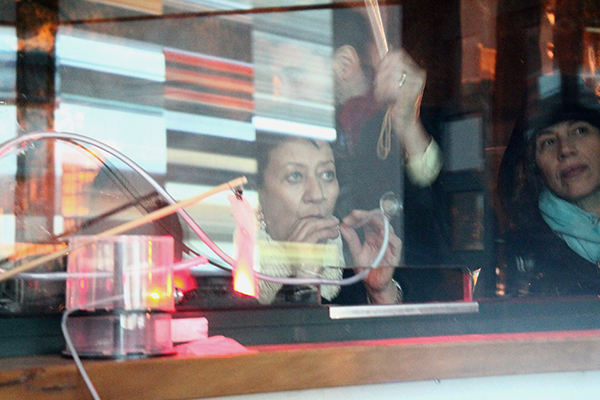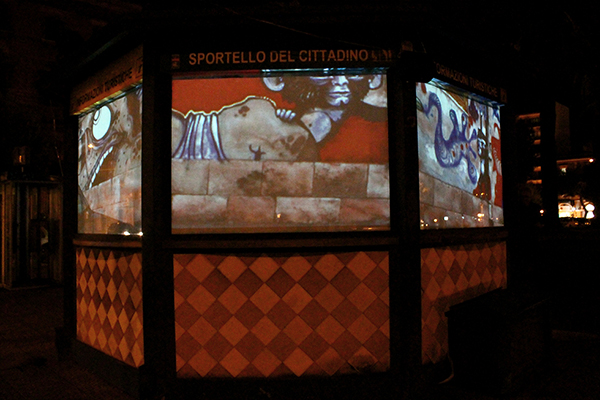CORRENTI SEDUTTIVE
Exhibition set up and Opening, 1st March 2014
"Parole d'Amore"
"Parole d'Onore"
"Parole di Dolore"
Love, Honour and Pain, which are the keywords of the three compositions, can be understood as the quintessence of the soul of Taranto.
"Parole d'Amore" consists of field recordings of a wedding ceremony and a religious procession through the alleys of the old town.
It is interrupted by love declarations of the Tarentinians to their city.
Stuttering, desperate, sarcastic is this self-description of Tarentinian citizens.
"Parole d'Onore" uses recurring text fragments taken from TV broadcasts about the environmental disaster of Taranto.
In their repetitions and replaceability these words describe the problem but in the end they remain just empty and inefficient.
Like gun shots those words burst into unreal and almost idyllic recordings of crickets chanting in the city.
"Parole di Dolore" is based on a poetry written by Alessandra Eramo in 2005, dealing with her pain for the fatal impact of the steel industry on the city.
These dark words are accompanied by field recordings of the industrial area and sounds of the navy fleet.
12 reportage drawings of every day life created during the artistic residency in Taranto (autumn 2013) are installed in front of the table with 3 record players.
The drawings in their seemingly quietness are screaming against the vanishing of an authentic culture of a society. This
process of dissolving which has started with the industrialization of Southern Italy in the 1960 and which was portrayed during the '90 as a necessary modernization
without alternative, now is understood from most of the people as what it really is: a big tragedy.
Printed on postcards, these drawings comment the hopes of the Tarentinians and the difficulty of establishing a cultural or touristic alternative in the city.
→ top
PETER CUSACK: Paesaggio Sonoro di Taranto
Sound installation, photographies
"ILVA Day, ILVA Night""
"Underwater Snapping and Popping in the Mar Piccolo"
"What Time Is It?"
"Dog and Subsidence"
"Crickets, Bangs, Echoes"
"Citta Vecchia contrasts"
"Soundscapes of Taranto" consists of a selection of field recordings chosen from a large number made last October during the residency.
Cusack is interested in what sounds tell us about landscapes, places, localities and what is happening there.
How different is the perspective of listening from that of sight or language? The field recordings are presented in combination with photographs
from the same locations and short texts that suggest more distant links and connections that might effect our individual interactions with what we hear.
Many of the Taranto sound recordings can be heard and explored in relation to satellite images of the city on the
Google map based website
1) ILVA Day, ILVA Night
ILVA, Taranto is the largest steel works in Western Europe.
The recording was made at night when ILVA's sounds are a constant presence in the area.
Depending on the wind direction they can be heard at a distance of six or seven kilometres.
2) Underwater Snapping and Popping in the Mar Piccolo
Sounds from an underwater microphone lowered into the water at Taranto's fishing harbour.
It is sea creatures, particularly snapping shrimps, going about their lives.
The Mar Piccolo is now so polluted by a combination of the Italian Navy dockyards and the ILVA steel
plant that mussels and other seafood have been declared unfit for human consumption.
3) What Time Is It?
Conversation with a diver. Mar Piccolo is very shallow and fishermen fish by hand.
It is an amazing skill and a bizarre sight. The men stand or lie half submerged and quite motionless
waiting for fish, easily visible in the translucent water, to swim by.
4) Dog and Subsidence
Tamburi, the district of Taranto closest to ILVA, suffers most from the pollution and other damage.
There is a playground that has collapsed because of subsidence made by constant leaks from the underground
pipes that carry Mar Piccolo water to the steel plant. The dog lives in the apartments
opposite and barks at everyone, especially strangers. The neighbours try to calm him, but cannot.
5) Crickets, Bangs, Echoes
Taranto New town. A warm night and teenagers play with loud bangs,
which ricochet from all the surrounding high buildings.
The singing crickets are not troubled.
6) Città Vecchia contrasts
Città Vecchia changes dramatically from street to street and building to building.
Some parts are full of life, shouts, children, and music. Others are derelict and abandoned and collapsing.
But even here the sounds of life can still be heard from distance. In the future hopefully these sounds will return everywhere.
ALESSANDRA ERAMO: Se Dio Vuole
Sound installation, Objects
"Ofeleia"
"Se Dio Vuole"
"5:30 am" and
"ILVA Drone and Seagulls Mar Piccolo's wharf"
Alessandra Eramo's sound installation "Se Dio Vuole" (God Willing) is dedicated to Mar Piccolo (the "Small Sea" bay of Taranto), its inhabitants and the fishermen who work there. It expresses the need of the artist to look once again at this place of incomparable beauty, the central place of Taranto that was forced to irrevocably change its traditional working patterns and purpose as mussel cultivation because of water pollution from industry and the navy. For this work, she focusses on sounds and "found objects" from Mar Piccolo and on the musicality of the Tarentinian dialect, dealing with her own relation to her place of birth. As a visual element Eramo employs a rough material of great historic resonance: A' Zoc', the ropes made of sparto grass, used for more than 2000 years for mussel cultivation. This object of historical and cultural importance for the whole Jonian region is here transfomed into a sound sculpture: In a tangle of ropes there are four black loudspeakers playing a vocal composition which is based on the guttural sounds of the Tarentinian dialect and on words in Ancient Greek whose linguistic heritage is present to this day in Tarentinian dialect. Despite the attempts of philologists, the sound of Ancient Greek remains unknown. Hence the artist tried to "give a voice" to words of pain and hope:
biaia: violence, violent acts
taras, tarantos: Taranto, from Taranto
tarantinos: Tarentinian
ofeleia: help, support
ota, ous: ear, ears
kataftora, katafteiro: ruin, defect, destruction, carnage, death
kataugazo: illumination, resplendence
eleferamenos: cruelty, injury, devastation
elpis, elpidos: hope, hopeful
Two other loudspeakers in the corners of the room play a melodic chant wrote and performed by the artist, which is inspired by the music of
the easter procession, traditionally played by a marching band. After the melodic chant starts an original field recording
made on Mar Piccolo's wharf, where the ear-splitting drone of the steel industry contrasts dramatically with the chant of the seagulls.
In the connecting room on a pedestal there's a poem written during the residency in October 2013,
which she dedicated to the Taranto Vecchia Island. On the other pedestal there are "found objects" from Mar Piccolo:
small and humble treasures as a one euro coin, a seashell and a still sealed surprise bag purchased for
one euro at the fair in honour of the Saints Cosma e Damiano.
At the pedestal's base 300 paperstrips with her original drawings are piled up and scattered,
building a sea of signs: Gestural and graphical transcriptions of the Tarentinian phonemes, scores of the sounds of the artist's mother tongue.
→ top
GEORG KLEIN: Le Due Forze di Taranto
Photographies, Sound installation
"Le Due Forze di Taranto"
"Le Due Forze di Taranto" has three parts, working with the conflicts of this city in South-Italy in a site-specific installation on two levels.
The city is trapped between two forces - the steel and petrochemical industry in the northwest and the navy in the southeast (NATO military port) -
and both they are polluting the air, the ground and the sea since decades, and they are restricting the live of the people in a physical way by walls and forbidden areas.
Since some years the residents of the city are protesting, independently from parties and unions, but also trapped by Taranto's big dilemma:
to protest against the main employers of the city.
The installation brings the political forces together in a condensed, aesthetic situation at a underpassing in the center of the city.
At Ponte Girevole - the connection between the new town and the old town, between the inland sea Mar Piccolo and the outer Mare Grande -
two double-sided photo plates were installed over the stairways. They represent the two ruling powers, standing vis-à-vis, visible on the street level,
but standing with their back to the city. On the second side of these plates there are shown two distinctive parts of the walls which cut through the city,
one by the wide area of the 'Marina Militare', one by the huge steel plant 'ILVA'.
On the low level in the underpassing a third force gets a voice, represented by a member of the independent organisation "Comitato".
In opposition to the representatives on top his face ist visible and also his voice is audible - of cause hidden in the underground
(and with an extra title: "Una Terza Forza di Taranto" - "A Third Power of Taranto"). Out of an interview with him on his personal
live as native Tarantino, as a worker in the steel plant and as a political activist a speech collage was made, broken by the disruption
between work and health, between environmentalism and breadwinning, interrupted by field recording sounds of special locations in the town, ILVA and the navy.
The second side of this photo plate shows one of the bricked up entrances of houses in the old city - a third type of walls,
which dominate the city, at least the old town close to the steel plant. Many people there left their houses in the last decades and walled the doors and windows.
Thus 3 persons and 3 walls give an immersive glimpse of Taranto's situation - a direct confrontation at a busy place, which gives the conflicts of the town a high
profile and keeps alive the voice of resistance, of change.
→ top
STEFFI WEISMANN: Sbuffa!
Audiovisual installation
"Sbuffa!"
In the Piazza Garibaldi in front of the Archaeological Museum Steffi
Weismann presents an audiovisual installation entitled "Sbuffa!" (Puff!) in a kiosk once used as an
information point for tourists and now abandoned. The people are invited to interact directly with the
projection displayed on the kiosk's windows, distorting, manipulating and influencing the images as they wish.
The images show the emblems of the city: smoke billowing from the chimneys or the opening of the swing bridge,
images which the inhabitants of the city see every day.

